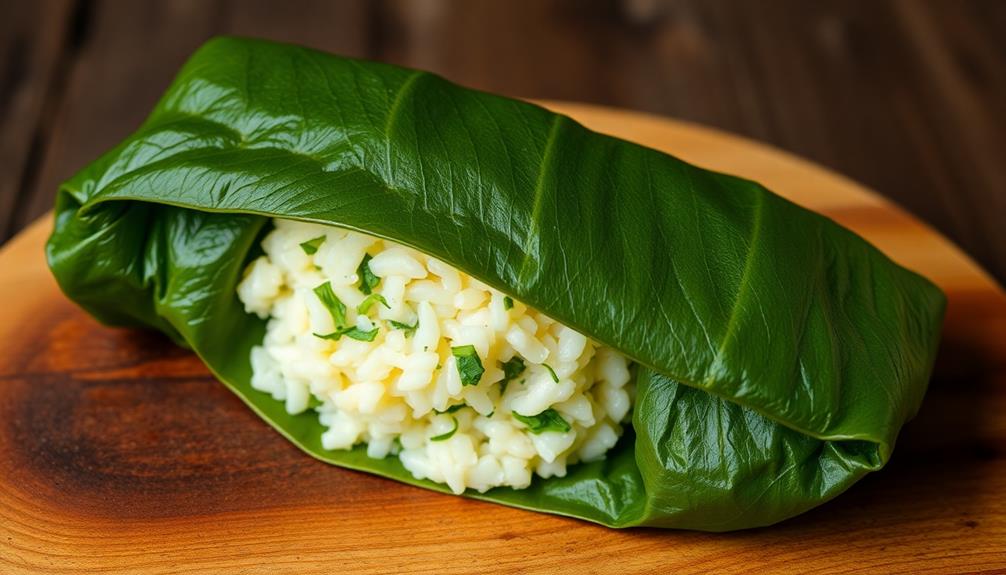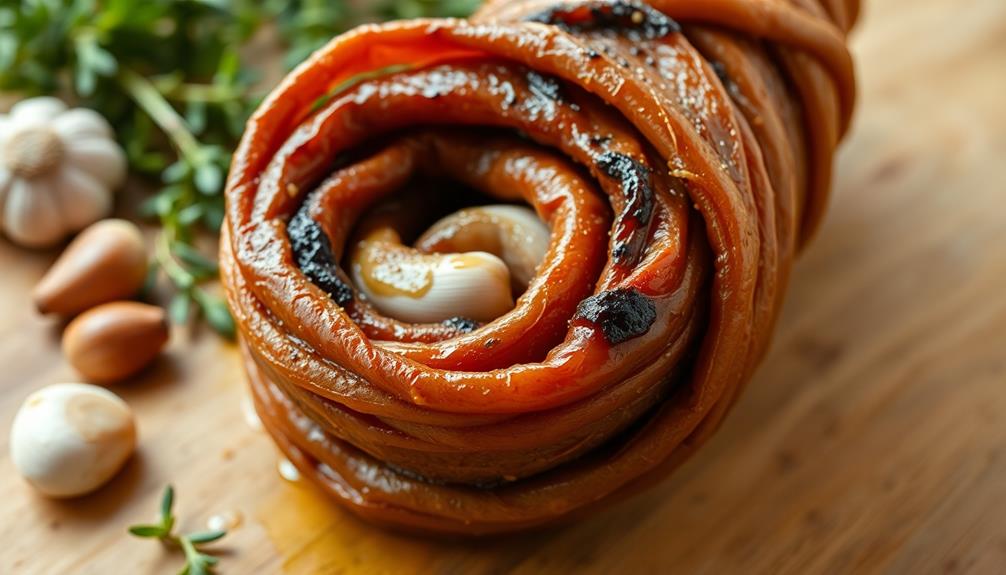Dolmades, the captivating Greek delicacy of stuffed grape leaves, have enchanted palates for centuries. You'll adore the fragrant filling of rice, onion, garlic, and fresh herbs, all wrapped in tender grape leaves. Preparing dolmades is a delightful culinary journey, as you'll soak the leaves, mix the savory filling, and snugly roll the packages. Serve chilled or at room temperature, complemented by a tangy lemon-based sauce. These low-calorie bites pack a nutritious punch, with fiber, antioxidants, and a vibrant presentation that'll impress your guests. Eager to learn more about the rich history and cultural significance behind this beloved Mediterranean dish? To truly appreciate the tradition of dolmades, one must delve into the retsina wine history, as the two are often enjoyed together in Greek cuisine. Retsina, a unique Greek wine flavored with pine resin, has been enjoyed for thousands of years, and its distinct flavor pairs exquisitely with the savory dolmades. The combination of retsina wine and dolmades reflects the deep roots of Mediterranean culinary customs and the way in which food and drink are intertwined with culture and history.
Key Takeaways
- Dolmades, or stuffed grape leaves, have a rich history dating back to ancient Greece and are a staple in Greek cuisine.
- The classic recipe features grape leaves stuffed with a savory filling of rice, herbs, and seasonings, creating a delightful balance of flavors.
- Preparation involves soaking grape leaves, creating a flavorful rice mixture, and carefully rolling and cooking the dolmades to perfection.
- Dolmades can be served as appetizers, side dishes, or light main courses, and they are easily adaptable for various dietary preferences.
- Dolmades are a nutritious and versatile dish, providing fiber, antioxidants, and a satisfying culinary experience that celebrates Greek culinary traditions.
History
The history of dolmades, the beloved Greek delicacy of stuffed grape leaves, can be traced back to ancient times.
Believe it or not, this tasty treat has been enjoyed for thousands of years! The earliest known record of dolmades dates back to the 4th century BCE, when the ancient Greeks would wrap minced meat and rice in tender grape leaves.
Over the centuries, the recipe has evolved, with different regions of Greece developing their own unique variations. Some use herbs and spices, while others incorporate vegetables or even seafood into the filling.
No matter the ingredients, the essence of dolmades remains the same – a delightful blend of flavors and textures that has captivated palates for generations.
Today, dolmades are a beloved part of Greek cuisine, savored as an appetizer, side dish, or light main course. Their rich history and enduring popularity make them a true classic.
Recipe
Dolmades are a classic Greek dish made of grape leaves stuffed with a flavorful rice and herb filling. These bite-sized delicacies aren't only delicious but also a testament to the rich culinary heritage of Greece.
Preparing dolmades can be a rewarding and engaging process, as it allows you to connect with the traditions of Mediterranean cuisine. The fragrant blend of herbs, tangy lemon, and tender rice creates a harmonious balance of flavors that will transport your taste buds to the sunny shores of the Aegean Sea.
Ingredients:
- 1 jar (about 40-50) grape leaves, drained and rinsed
- 1 cup uncooked short-grain rice
- 1/2 cup chopped onion
- 2 cloves garlic, minced
- 1/4 cup chopped fresh parsley
- 2 tablespoons chopped fresh mint
- 1 tablespoon chopped fresh dill
- 1/4 cup olive oil
- 1/4 cup lemon juice
- 1 teaspoon salt
- 1/4 teaspoon black pepper
Instructions:
In a saucepan, cook the rice according to package instructions. Fluff the rice and allow it to cool slightly.
In a bowl, combine the cooked rice, onion, garlic, parsley, mint, dill, olive oil, lemon juice, salt, and pepper. Mix well.
Lay a grape leaf shiny-side down, with the stem end towards you. Place approximately 1-2 tablespoons of the rice mixture near the stem end. Fold the stem end over the filling, then fold in the sides and roll up tightly.
Place the dolmades seam-side down in a large pot. Repeat with the remaining grape leaves and filling.
Tips:
- If the grape leaves are stiff, briefly dip them in hot water to soften before use.
- Adjust the lemon juice and seasoning to your taste preference.
- Serve the dolmades chilled or at room temperature, accompanied by a tangy yogurt or lemon-based sauce for dipping.
Cooking Steps
First, you'll need to rinse and soak the grape leaves to soften them.
Next, prepare the savory rice filling mixture.
Then, carefully stuff and roll each leaf into a neat little package.
Arrange the stuffed dolmades in a baking dish, and get ready to cook them to perfection.
Step 1. Rinse and Soak Grape Leaves

Rinse the grape leaves thoroughly under cool running water. This step helps remove any dirt, debris, or blemishes that may be clinging to the leaves. Gently separate each leaf, taking care not to tear or damage them.
Once rinsed, you'll need to soak the leaves in water for about 30 minutes. This softens the leaves, making them more pliable and easier to work with when it's time to stuff and roll them.
During the soaking process, you may need to add a bit more water to keep the leaves submerged. Occasionally, give the leaves a gentle stir to ensure they're all being evenly softened.
After 30 minutes, drain the leaves and pat them dry with a clean, absorbent towel. The leaves are now ready to be stuffed with your delicious filling.
Be gentle as you handle them, as they can tear easily when wet. With the leaves prepped, you're one step closer to creating mouthwatering dolmades!
Step 2. Prepare Rice Filling Mixture
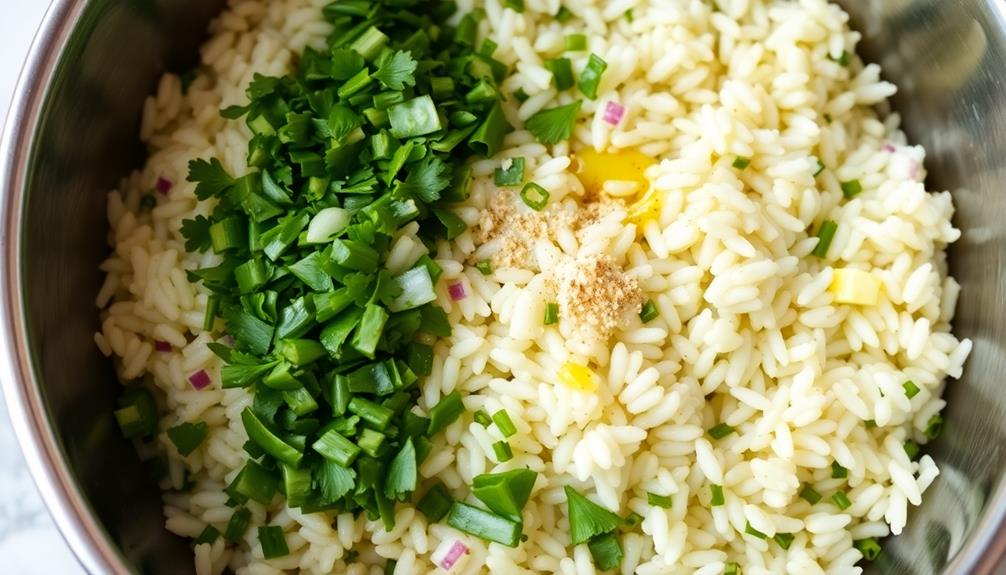
The rice filling mixture is the heart of dolmades, infusing them with aromatic flavor.
In a large bowl, combine 1 cup of short-grain rice, 1 finely chopped onion, 2 minced garlic cloves, 1/4 cup of chopped parsley, 2 tablespoons of lemon juice, 1 teaspoon of dried mint, and a pinch of cinnamon.
Season with salt and pepper to taste. Mix everything together until well combined. The savory rice filling should have a slight herbal aroma and a balance of flavors.
Gently spoon a tablespoon of the mixture onto the center of each prepared grape leaf. Fold the sides of the leaf over the filling, then roll it up tightly to form a neat little package.
Repeat this process until you've used up all the filling or grape leaves. Your homemade dolmades are now ready to be simmered in a flavorful broth, transforming them into tender, flavor-packed bites.
Step 3. Stuff and Roll Grape Leaves
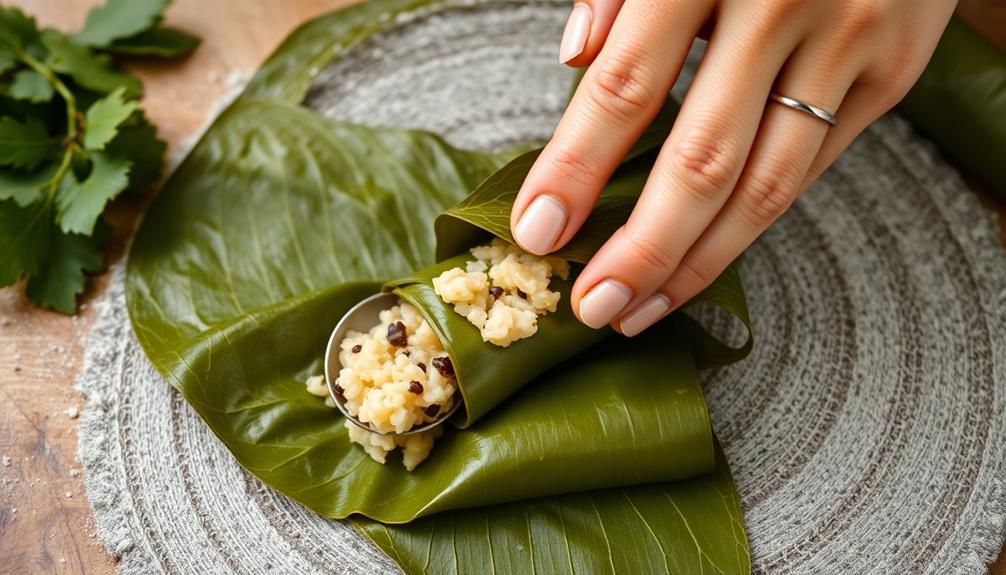
With the savory rice filling ready, you can now begin stuffing and rolling the grape leaves. Gently unfurl a single grape leaf, taking care not to tear it.
Place a heaping teaspoon of the rice mixture near the stem end of the leaf. Fold the sides of the leaf over the filling, then tightly roll the leaf from the stem end to the tip, creating a neat little package.
Arrange the stuffed grape leaves seam-side down in a baking dish or pot. Continue this process, tightly packing the dolmades side by side until all the filling is used.
The key is to roll them snugly, but not too tightly, as the rice will expand during cooking. Once all the leaves are stuffed, you're ready to cook your homemade dolmades.
The fragrant, savory-filled grape leaves will transport you to the sunny Mediterranean with every bite.
Step 4. Arrange Dolmades in Baking Dish

Carefully arrange the stuffed grape leaves, seam-side down, in a baking dish or pot. Gently place each dolmade snugly against the others, creating a compact, organized layout. This helps the leaves hold their shape as they cook.
Feel free to layer the dolmades, stacking them neatly to fit more in the dish. Once you've arranged the entire batch, take a step back and ensure they're evenly distributed with no gaps. If needed, rearrange a few to achieve a uniform, aesthetically pleasing presentation.
Next, pour the cooking liquid – typically a mixture of broth, lemon juice, and olive oil – over the dolmades until they're submerged. This liquid will infuse the leaves with flavor and keep them moist during baking.
Step 5. Cook Dolmades
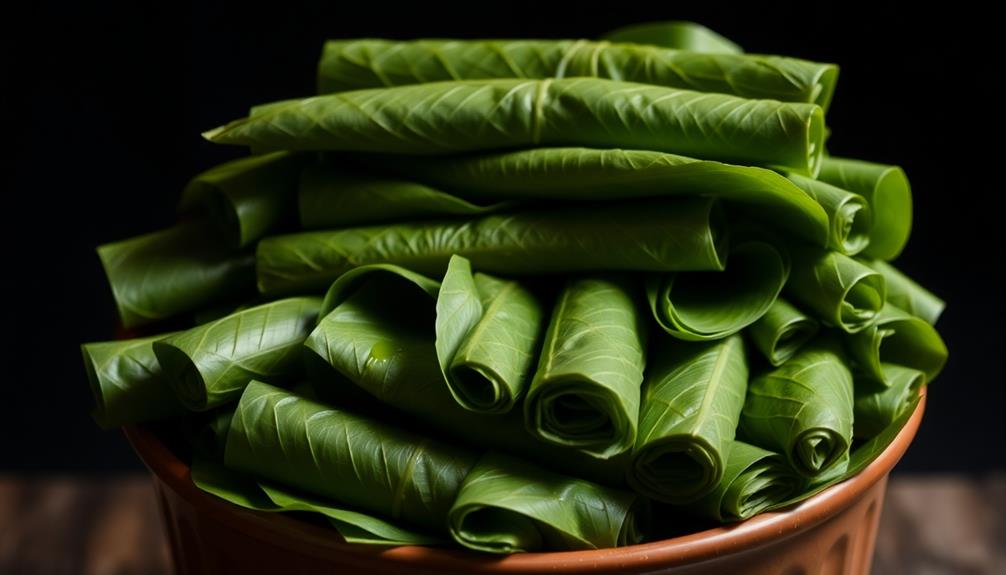
Preheat your oven to 350°F (175°C). Carefully place the arranged dolmades in the prepared baking dish, seam-side down. This helps them hold their shape as they cook. Drizzle the dolmades with the reserved lemon-olive oil mixture, ensuring each one is evenly coated.
Next, pour the hot vegetable broth or water around the dolmades, being careful not to submerge them completely. This creates a steaming environment that will cook the leaves and filling to perfection. Cover the baking dish tightly with aluminum foil, crimping the edges to seal in the moisture.
Bake the dolmades for 45-60 minutes, until the leaves are tender and the filling is heated through. The timing may vary depending on the size of your dolmades.
Once done, carefully remove the foil and let the dolmades cool for a few minutes before serving. Enjoy the tantalizing aroma and the satisfying flavors of your homemade dolmades!
Final Thoughts
Ultimately, dolmades are a delightful addition to any Mediterranean-inspired meal. Their vibrant colors, tantalizing flavors, and delicate texture make them a true delight for the senses.
Whether served as an appetizer, a side dish, or part of a larger spread, dolmades are sure to impress your guests and leave them craving more.
The process of making dolmades may seem daunting at first, but with a little practice, you'll be rolling them up like a pro. The satisfaction of creating these homemade delicacies is unparalleled, and the aroma that fills your kitchen will have your mouth watering.
Experiment with different fillings and seasonings to find your perfect flavor combination, and don't be afraid to get creative.
Dolmades are a versatile and nourishing dish that can be enjoyed year-round. Whether you're hosting a dinner party or simply indulging in a midday snack, these stuffed grape leaves are sure to delight.
Frequently Asked Questions
Are Dolmades Gluten-Free?
Yes, dolmades are typically gluten-free. Grape leaves don't contain gluten, and the rice or bulgur filling in dolmades is also usually gluten-free. Just be sure to check the specific recipe or ingredients if you have a gluten allergy.
Can I Use Fresh or Jarred Grape Leaves?
You can use either fresh or jarred grape leaves to make your dish. Fresh leaves may require more prep work, but they'll provide a more authentic flavor. Jarred leaves are more convenient, though the taste might not be as vibrant.
How Long Do Dolmades Last After Being Cooked?
After being cooked, your dolmades will last about 3-5 days when stored properly in the refrigerator. They'll keep their flavor and texture best if you consume them within this timeframe.
Can I Freeze Dolmades for Later Use?
You can absolutely freeze dolmades for later use. Simply let them cool completely, then pack them in an airtight container or freezer bag. They'll keep well for several months in the freezer, so you can enjoy them anytime.
Do Dolmades Need to Be Refrigerated?
Absolutely! To keep dolmades fresh, you'll need to refrigerate them. Once cooked, store them in an airtight container in the fridge for up to 4-5 days. This will help maintain their flavor and texture.
